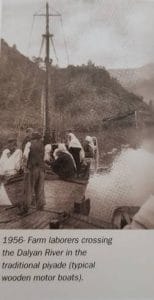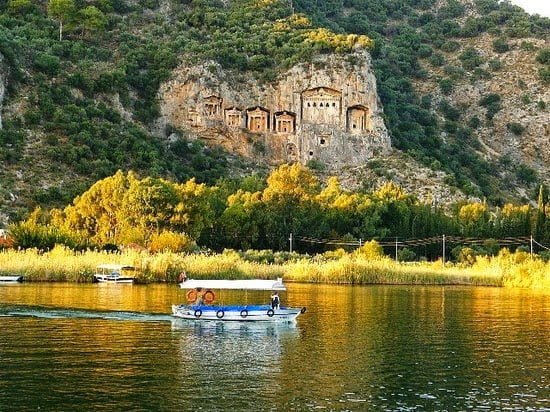“The entire tribe moved to the autumn camp
I am the chieftain whose tribe remained in the winter camp”– An old song of the Kalecik nomads
After Seljuk Sultan Alparslan’s victory over the Byzantine army on Manzikert plain in 1071, Anatolia became the Turkish homeland. Kilic Arslan II added almost all of Caria to the lands of the Selcuk State with his raids during 1093-1095. The settling of Turkish tribes coming in waves from central Asia in Western Anatolia against the Byzantine border accelerated this spread. Anatolia was shared among small emirates that became independent during the chaotic period which started when the Mongols took Anatolia after the Anatolian Selcuks were defeated by the Mongol Ilkhanate in the battle of Kösedag in 1243 and lasting until 1300. This state of affairs continued until Sultan Mehmed II, the Conqueror united Anatolia until Ottoman rule.

One of these emirates, Menteşeogulları, ruled a wide territory centred in Peçin (Milas), which extended from Çine and Ayasulug (Selçuk) in the north to Köycegiz in the south. Köycegiz is mentioned as a township in records from the Menteşeogulları period. This status continued during Ottoman rule, as well. The Province Charter of 1876 states eight towns were attached to the Mentese Sanjak (state). These towns were Mugla (central town), Peçin (Milas), Bozüyük Dayta (Datçal, Megri (Fethiyel, Tavas and Koyceğiz The Nomadic and Turkmen tribes that found the Menteşe Emirate were highly regarded as seamen in the Western Aegean.
TIP – You can visit and learn in depth about Mugla on our Mugla Undiscovered tour.
They the advantage of the natural harbours along the coasts and of the timber rich forests suitable for shipbuilding. With the help of the fleet they build they came to occupy a large part of Rhodes for the reign of Mesut Bey. Also, the Menteşe Emirate formed an important trade network to market its agriculture and forestry products by sea.


Turkmen tribes living in mountainous regions occupied in cattle breeding and lumbering were called “Tree Men”, while the naval soldiers were known as “The Levents” were recruited from the Mentese Province. The ancient Carian tradition of shipbuilding and seamanship continues to thrive even today. Until the end of the 19th century lumber obtained from the forests around Köycegiz were brought to the lake by way of small rivers, towed through the Dalyan River using sailboats and then transferred to large boats anchored near Delik Ada in the sea. After the 13th century, this economic bustle enabled the further development of both Köycegiz, as a lake port and Dalyan, as a settlementi the only one on the channel that connected the lake to the sea).
During the period of the Anatolian Emirates, land was organised as estates and hereditary  endowments. The Ottomans put an end to this system and nationalised the land, regulating it a harici (external), öşrü (tithed) and miri (demesne lands, agricultural and husbandry products, industrial operations, natural resources and customs revenues were divided into taxes called “has/ ueamet” and “timar” according to their origins “has” revenues belonged to the sultan and his family while the “zeamet” revenues were allocated senior civil servants as pay. The “timars” would be awarded to those who demonstrated heroism in war and provided a means of sustenance to those who were then required to equip and train a certain number of mounted soldiers. During the principality of Yavuz Sultan Selim, Köycegiz was assessed as a “has” that brought a revenue 21.000 akches. Apart from the “has”, there was also a large population paying “zeamet”. For instance, while the Günkas, who were given land in the Cireniz Village were paid 50,000 akches, 18 communities living in 884 houses in Köycegiz paid 35.000 akches. There were also many “timars'” attached to the town of Köycegiz (Karaagaç-2006)
endowments. The Ottomans put an end to this system and nationalised the land, regulating it a harici (external), öşrü (tithed) and miri (demesne lands, agricultural and husbandry products, industrial operations, natural resources and customs revenues were divided into taxes called “has/ ueamet” and “timar” according to their origins “has” revenues belonged to the sultan and his family while the “zeamet” revenues were allocated senior civil servants as pay. The “timars” would be awarded to those who demonstrated heroism in war and provided a means of sustenance to those who were then required to equip and train a certain number of mounted soldiers. During the principality of Yavuz Sultan Selim, Köycegiz was assessed as a “has” that brought a revenue 21.000 akches. Apart from the “has”, there was also a large population paying “zeamet”. For instance, while the Günkas, who were given land in the Cireniz Village were paid 50,000 akches, 18 communities living in 884 houses in Köycegiz paid 35.000 akches. There were also many “timars'” attached to the town of Köycegiz (Karaagaç-2006)
When the “dirlik system” started to crumble by the end of the 15th century, another system called “iltizam” was adopted. This regulation based on the self-sufficiency of the provinces according to their revenues lost its functionality by the 18th century, when the Ottoman Empire was in decline. Province and sanjak administrators assigned by the palace started to remain in Istanbul and appoint mütesellims (proxies) from among the prominent citizens of the region. This caused ayans (lords] and mütesellims, who appropriated vast tracts of land, to gain power and oppress the people of their regions. The Menteşe sancak and Koycegiz, a town of this sancak, was controlled by mütesellims between 1739 and 1839, the year of the Tanzimat (Reform) Charter.
When the Land Code, passed in 1858, recognised private land ownership, the titles of the former timar lands were given to the families who had been tilling these soils for centuries. At which time, Köycegiz town and the large tracts of land surrounding it became Ali Pasha’s farm, and larger farms such as Beyobası, Zeytin Alanı, Toparlar, Hamitköy, Dögüşbelen and Sultaniye were founded around Köycegiz (Karaagaç-2006).

Source: Koycegiz – Dalyan A Journey Through History Within The Labyrinth of Nature, (pages: 19-22), Altan Türe, 2011, Faya Kültürel Yayınları



Comments